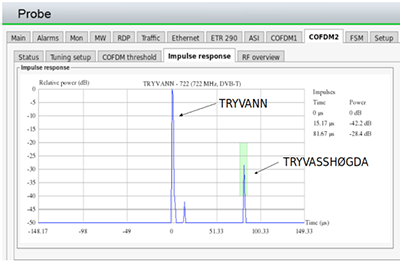VB252

VB252: DVB-T/T2 TERRESTRIAL RF INPUT MODULE
VB252 is a DVB-T / T2 dual input interface, which uses ground transmission monitoring. The two modules can be accommodated in a 1RU machine together with the VB120 or VB220 Probe controller to occupy the smallest rack space and provide high-capacity monitoring functions.

The picture shows a 1RU enhanced machine with a VB120 module and two VB252 DVB-T / T2 input modules, a total of 4 independent RF inputs.
In addition to monitoring typical RF parameters, optional advanced data in the complex DVB-T MI protocol; signal integrity is based on the verification layer. In addition, VB252 also supports T2 Lite standard accelerator for comprehensive analysis. All analysis functions integrate bridge technology and ETSI TR101290 monitoring engine to ensure compliance with standards.

The picture shows the channel impulse response diagram used to view the off-air monitoring and SFN alarm
In a typical DVB-T / T2 system transmitter site is distributed through IP infrastructure or through satellite distribution. The bridge technology range of interfaces and interface modules can easily monitor the entire point-to-point signal chain. When combined with VB120 / VB252, it can monitor up to 50 multicast IP streams, and then monitor the distribution of IP network and DVB-T2 transmission status.
In contrast, VB252 and VB242 can be used in ASI input modules to achieve high-density ASI and DVB-T / T2 monitoring.
Basically VB252 supports a COFDM RF input. The second input of VB252 can be used via software license option. This flexibility allows Probe capacity to be adjusted according to the needs of individual systems, and expanded to include monitoring systems, as well as including more transport streams.
From the VB252 advanced RF impulse response graph and analysis, it is possible to detect reflection conditions at the Probe location. Threshold values can be set to determine when to implement an alarm, which increases in response to changes in time or power reflection.
Convenient GUI measurement and interpretation of impulse response analysis results become the user's favorite. The upgrade is performed by entering the normal Probe GUI license key and supporting remote control.
Technical characteristics
- Choice between 50 ohm female SMA (VB252-SMA) or 75 ohm female F-type connectors (VB252)
- 50 ohm female SMA 1-pulse-per-second GPS input for SFN Drift measurements
- 9-pin D-Type male connector for relay alarm indication
- One red/green LED TS sync indicator per RF input
- Supports DVB-T EN 300-744 and DVB-T2 EN-302-755
- Frequency range 43 - 1002 MHz
- Symbol rate range 0.7 - 7.2 Msym/s
- All versions of DVB-T2 supported: 1.1.1, 1.2.1 and 1.3.1
- DVB-T2 Base and DVB-T2 Lite profiles supported (1.3.1)
- Channel bandwidth: 1.7 (T2-Lite only), 5, 6, 7 and 8 MHz
- Round-robin capability across multiple PLPs within one frequency
- Capable of monitoring the following RF parameters:
- Channel power RF level
- Modulation Error Rate MER(PLP)
- Signal to Noise Ratio SNR
- Center Frequency Offset
- Spectrum sense
- 1PPS Input Lock
- Pre Viterbi BER (DVB-T)
- Pre Reed Solomon BER (DVB-T)
- Pre LDPC BER (DVB-T2)
- Pre BCH BER (DVB-T2)
- Post BCH FER (DVB-T2)
- Packet Error Rate
- LDPC Iterations count - DVB-T SFN Drift monitoring for measuring absolute transmission time of mega frame
- DVB-T2 SFN Drift monitoring by measuring timing of T2MI frame versus received RF super frame
- Readout of TPS information (DVB-T)
- Readout of signalled L1 and PLP parameters (DVB-T2)
- Channel impulse Response diagram
- Constellation diagram
- SFN Drift monitoring for DVB-T
- SFN Drift monitoring for DVB-T2
- Extract and display over 30 signalled DVB-T2 L1 Pre information parameters
- Extract and display over 20 signalled DVB-T2 L1 PLP information parameters
- Extract and display 9 signalled DVB-T2 L1 Post information parameters
RF signal specifications
- RF power level: -80 dBm to -20 dBm
- RF power level accuracy: +/- 1.5 dB
- RF power level resolution: 1 dB
- Maximum SNR: > 38dB +/- 1.5dB
- Maximum MER: > 38dB +/- 1.5dB
- Carrier offset: < 15 ppm of tuning frequency
- SFN drift: 0 to 500ms
- SFN drift accuracy: +/- 2us





